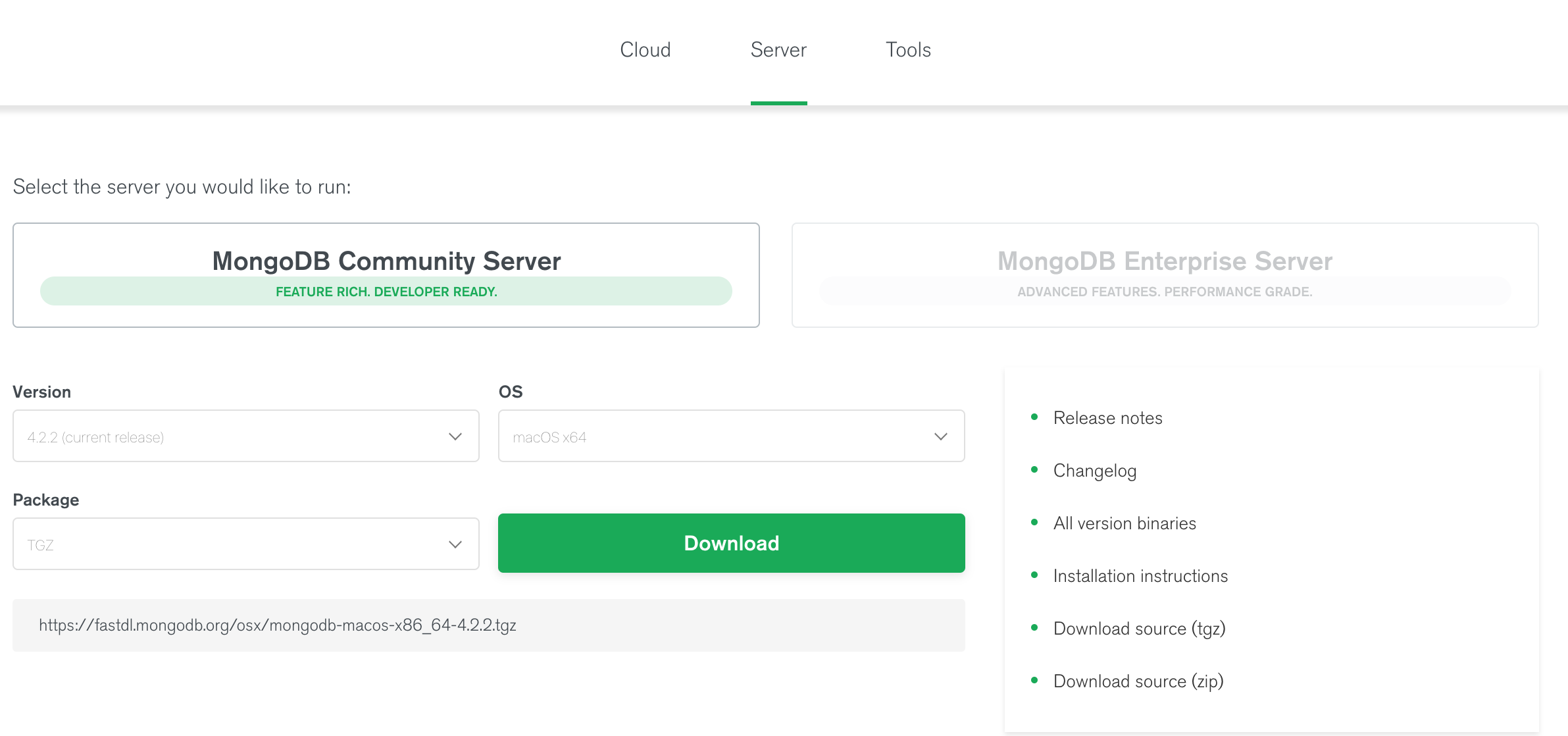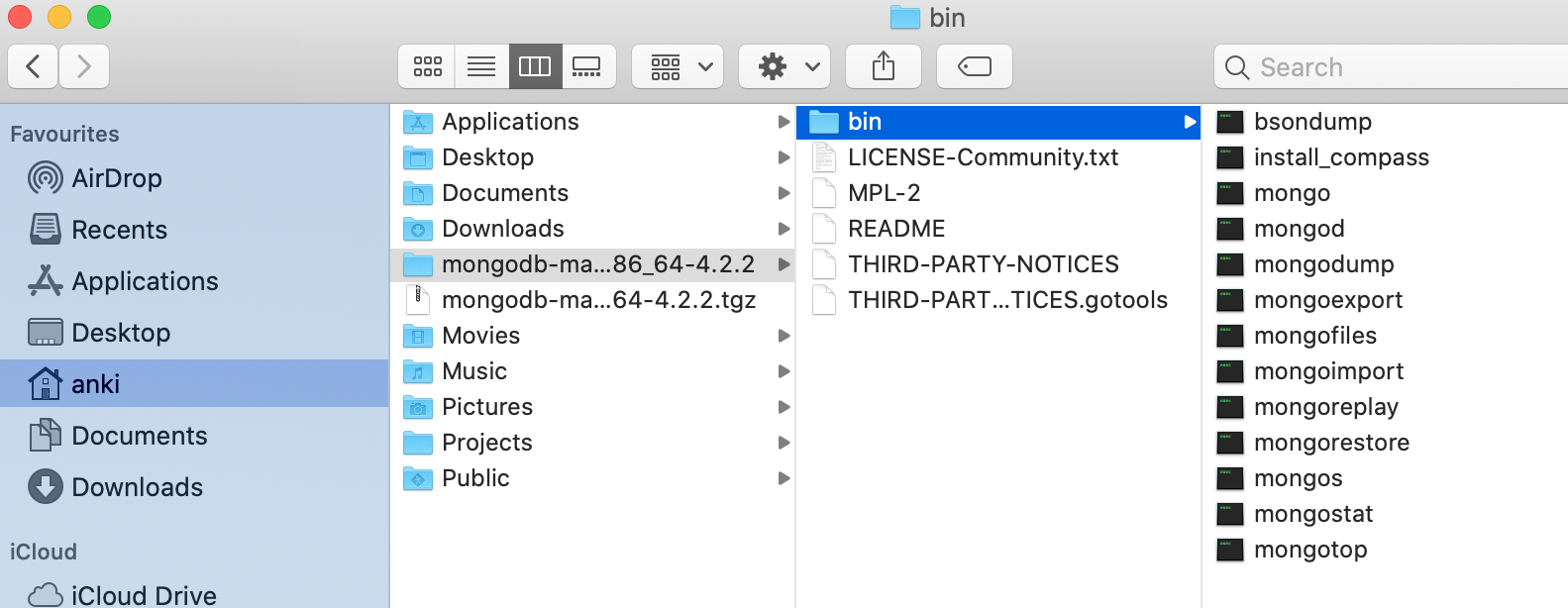- Install Mongodb On Mac Catalina
- Install Mongodb On Mac Catalina Free
- Install Mongodb On Mac Catalina Operating System
- How To Install Mongodb On Macos Catalina
Today, you'll learn to install the MongoDB community edition on macOS Catalina and higher. Creating Data Folder. Before you install and use MongoDB, you need to create a data/db folder on your computer for storing MongoDB data. Before macOS Catalina, you can create this folder in the user's root directory with the following command.
Installation
- Download Visual Studio Code for macOS.
- Open the browser's download list and locate the downloaded archive.
- Select the 'magnifying glass' icon to open the archive in Finder.
- Drag
Visual Studio Code.appto theApplicationsfolder, making it available in the macOS Launchpad. - Add VS Code to your Dock by right-clicking on the icon to bring up the context menu and choosing Options, Keep in Dock.
Launching from the command line
MongoDB expects the Data/data/db folders to be in a location which Mac OS Catalina does not allow. As a consequence the folders must be placed elsewhere, on one of the disk volumes. But modifying the MongoDB settings to find the new data folders is not working properly. There are many supposed solutions for this in various places on the web but none of them have solved my issues. This site contains user submitted content, comments and opinions and is for informational purposes only. Apple may provide or recommend responses as a possible solution based on the information provided; every potential issue may involve several factors not detailed in the conversations captured in an electronic forum and Apple can therefore provide no guarantee as to the. วิธีติดตั้ง MongoDB บน Mac (Catalina) คำแนะนำสั้น ๆ ในการติดตั้งและตั้งค่า MongoDB.

You can also run VS Code from the terminal by typing 'code' after adding it to the path:
- Launch VS Code.
- Open the Command Palette (Cmd+Shift+P) and type 'shell command' to find the Shell Command: Install 'code' command in PATH command.
- Restart the terminal for the new
$PATHvalue to take effect. You'll be able to type 'code .' in any folder to start editing files in that folder.
Note: If you still have the old code alias in your .bash_profile (or equivalent) from an early VS Code version, remove it and replace it by executing the Shell Command: Install 'code' command in PATH command.
Alternative manual instructions

Instead of running the command above, you can manually add VS Code to your path, to do so run the following commands:
Start a new terminal to pick up your .bash_profile changes.
Note: The leading slash is required to prevent $PATH from expanding during the concatenation. Remove the leading slash if you want to run the export command directly in a terminal.
Note: Since zsh became the default shell in macOS Catalina, run the following commands to add VS Code to your path:
Touch Bar support
Out of the box VS Code adds actions to navigate in editor history as well as the full Debug tool bar to control the debugger on your Touch Bar:
Mojave privacy protections
After upgrading to macOS Mojave version, you may see dialogs saying 'Visual Studio Code would like to access your {calendar/contacts/photos}.' This is due to the new privacy protections in Mojave and is not specific to VS Code. The same dialogs may be displayed when running other applications as well. The dialog is shown once for each type of personal data and it is fine to choose Don't Allow since VS Code does not need access to those folders. You can read a more detailed explanation in this blog post.
Updates
VS Code ships monthly releases and supports auto-update when a new release is available. If you're prompted by VS Code, accept the newest update and it will get installed (you won't need to do anything else to get the latest bits).
Note: You can disable auto-update if you prefer to update VS Code on your own schedule.
Preferences menu
You can configure VS Code through settings, color themes, and custom keybindings available through the Code > Preferences menu group.

You may see mention of File > Preferences in documentation, which is the Preferences menu group location on Windows and Linux. On a macOS, the Preferences menu group is under Code, not File.
Next steps
Once you have installed VS Code, these topics will help you learn more about VS Code:
- Additional Components - Learn how to install Git, Node.js, TypeScript, and tools like Yeoman.
- User Interface - A quick orientation around VS Code.
- User/Workspace Settings - Learn how to configure VS Code to your preferences settings.
Common questions
Why do I see 'Visual Studio Code would like access to your calendar.'
If you are running macOS Mojave version, you may see dialogs saying 'Visual Studio Code would like to access your {calendar/contacts/photos}.' This is due to the new privacy protections in Mojave discussed above. It is fine to choose Don't Allow since VS Code does not need access to those folders.
VS Code fails to update
If VS Code doesn't update once it restarts, it might be set under quarantine by macOS. Follow the steps in this issue for resolution.
Does VS Code run on Mac M1 machines?
Yes, VS Code supports macOS ARM64 builds that can run on Macs with the Apple M1 chip. You can install the Universal build, which includes both Intel and Apple Silicon builds, or one of the platform specific builds.
This article shows how to install Maven (3.6.3) on macOS Big Sur (version 11.1).
Topics
Related Articles
1. Homebrew install Maven on macOS
1.1 Install Homebrew, a package manager on macOS.
1.2 The command brew install maven will install the latest Maven.
1.3 Done. The Maven is installed on macOS.
P.S At the time of writing, the latest Maven version is 3.6.3

1.4 Where does Homebrew installed the Maven?
The brew will install the Maven packages at /usr/local/Cellar/maven/${version}
The brew also creates shortcut or symbolic links at /usr/local/opt/maven/
1.5 Where does Homebrew put the Maven configuration file, settings.xml?
The settings.xml is available at /usr/local/opt/maven/libexec/conf
1.6 Where does Homebrew put the core mvn executable file?
The mvn is at /usr/local/bin/
1.7 brew info maven to show the detail of the Maven package.
1.8 brew list maven
1.9 Useful commands:
brew upgrade mavento upgrade Maven.brew uninstall mavento uninstall Maven.
2. Install Maven Manually
If Homebrew failed you or you don’t want the black-box magic, try to install the Maven manually.
2.1 Download the Maven, for example apache-maven-3.6.3-bin.tar.gz
2.2 The below command extracts the downloaded .tar.gz file to the current user’s home directory ~
2.3 Now, the Maven folder is at this path /Users/mkyong/apache-maven-3.6.3
Install Mongodb On Mac Catalina
2.4 On macOS 10.5 Catalina or later, the default shell is zsh, and we can create the environment variables MAVEN_HOME and update the PATH in ~/.zshenv.
Open the ~/.zshenv and append the following content.
Note
For macOS 10.14 Mojave and before, the default Terminal shell is bash, and we can create the environment variables in ~/.bash_profile.

Open the ~/.bash_profile and append the following content.
P.S Read this Zsh Startup Files.
2.5 Source the ~/.zshenv to reflect the changes.
Install Mongodb On Mac Catalina Free
2.6 Verification.
Done.